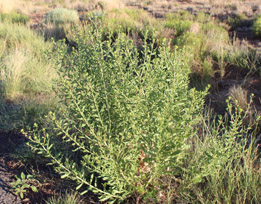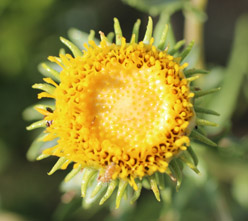 |
 |
Food:
"Some tribes chewed on gumweed on gumweed leaves or used them fresh or dried to make an aromatic tea." (Kershaw 186)
"During the archaeological salvage project in advance of the construction of Cochiti Dam, gumweed seeds were found preserved in a prehistoric bowl. Since they were mixed with highly palatable amaranth seeds, gumweed seeds may have had a dietary connection."(Dunmire and Tierney 220)
Medicine:
"Tea made from the resinous flowerheads was taken to relieve indigestion, colic and stomachaches. The leaf tea was used to treat throat and lung problems such as coughs, bronchitis and asthma. It was also widely used as a wash to relieve itching and to heal minor cuts and abrasions, pimples and skin irritations (especially rashes caused by poison-ivy). A leaf poultice or the gum from pounded flowerheads was applied to poison-ivy inflammations and minor skin problems. Extracts from the dried flowerheads and leaves are said to have sedative, antispasmodic and expectorant qualities. They were once recommended as a treatment for a wide range of ailments, including headaches, malaria, cancers of the spleen and stomach, gonorrhea, pneumonia, rheumatism, smallpox and tuberculosis. More recently, they have been used in medications for treating asthma and bronchitis, and some herbalist recommend them for treating bladder inflammations caused by fungi or food." (Kershaw 186)
"Puebloan uses during this century include gumweed herbal tea drunk for kidney problems at Picuris and San Juan and for stomachaches at Acoma and Laguna. A liquid of dried and boiled parts was once used for cleaning skin abrasions at Jemez, and a paste of ground herbage was applied to sores by Picuris Puebloans. At Cochiti the sticky blossoms would be placed on an aching tooth." (Dunmire and Tierney 220)
"With consistent regard for the potential influence of magical numbers, Spanish New Mexicans boil three times three yerba del buey buttons (buds or flowers) in three pints of water, until only one pint of liquid remains. This should be taken for kidney disorders by the wineglassful, three times a day. As it has a very bitter taste, a little piloncillo (Mexican brown sugar) often is added.
The herb also has a reputation for the easing of rheumatic pains when the fresh, green plants are crushed and applied.
During the winter, for resfrio en los huesos, 'cold in the bones,' the dried sprigs are thoroughly sprinkled with hot water and a quantity is piled on a heated adobe brick. The whole is wrapped in a cloth and held beside the aching parts. The steam emanating from this preparation effects the cure." (Curtin 179)
"A tea for bronchitis and wherever an expectorant is needed. It is a useful antispasmodic for dry hacking coughs---.
A mild sedative and cardiac relaxant, although not always reliable. Its unpleasant bitterness makes it useful as a mild stomach tonic." (Moore 80)
Other Uses:
"Plant tops and leaves were used to make washes for healing saddle sores on horses." (Kershaw 186)
"Natural remedies (to poison ivy): sticky gumweed, ---" (Seebeck 157)
"Yerba del buey not only is devoted to medicinal purposes, but is found useful in making brooms for the threshing floor, and children delight in teasing one another by sticking the resinous buds o their victims' faces." (Curtin 180)